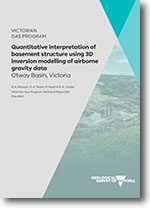VGP Technical Report 63 - Quantitative interpretation of basement structure using 3D inversion modelling of airborne gravity data
 |
| |||||||||||||||
Product description:About the Victorian Gas Program: The Victorian Gas Program (VGP) is a comprehensive science-led program, incorporating geoscientific and environmental research to assess the risks, benefits and impacts of potential onshore conventional gas exploration and production. The program is also investigating the potential for further discoveries of onshore conventional and offshore gas in the Otway and Gippsland geological basins and assessing the feasibility of additional onshore underground gas storage in depleted reservoirs around the Port Campbell area. The VGP includes an extensive, proactive and phased community and stakeholder engagement program, through which the results of the scientific studies are being communicated. Executive summary: As part of the Victorian Gas Program (VGP), the Geological Survey of Victoria (GSV) is studying the Otway Basinís petroleum systems components (reservoir, seal and source), to assess its petroleum prospectivity and to estimate the potential for further conventional gas discoveries onshore and offshore within Victoriaís jurisdiction. As part of the VGP, between June 2018 and January 2019, the Geological Survey of Victoria conducted an airborne gravity and gravity gradiometry survey (Full Spectrum Falcon) over the on- and near-shore Otway Basin. The objective of this survey was to acquire a valuable open-file pre-competitive geoscientific dataset and to improve Geological Survey of Victoria geological models by further constraining the Otway Basinís geometry and the geological characterisation of the underlying pre-Mesozoic basement rocks. The three-dimensional (3D) geometries of geological structures can be tested quantitatively against geophysical data using a 3D forward modelling and inversion approach. Three-dimensional forward modelling is a technique that involves construction of geological 3D computer models, assigning rock property data (such as density) to packages of rocks, and calculating the synthetic gravity response of the theoretical model. This calculated gravity response of the 3D model can be compared with the observed response which, in this survey, was acquired by aircraft. The difference between the calculated and observed response (the residual gravity response) indicates a mis-match, where changes to the 3D model need to be made. Three-dimensional geophysical inversion progresses this workflow further and employs a stepwise process whereby the boundaries between geological horizons and/or their properties (e.g. density) are computationally adjusted through iteration to achieve a match between the calculated and observed response. Importantly, the geometries of geological bodies and structures are constrained using a variety of datasets including surface observations, well data and seismic reflection data interpretations. Inevitably, refinement of geometries through inversion applied to an inadequate starting model can cause the model to become inconsistent with these data constraints prompting for modifications (e.g. local introductions of additional structures and/or rock-types of different density) to the model to honour known constraints, before further inversion iterations are performed. The process is very recursive and involves seeking a balance between honouring geological constraints and building a model which is consistent with the gravity data. The approach applied to the Otway Basin was to use the existing seismic reflection data interpretations as a starting model and attempt to refine the geometry, particularly of the top of basement interface with Otway Basin sediments. The challenge with gravity modelling is that the observed data is the net response of the gravity signature of all rocks from the surface down into the mantle. Not only does this mean that the geology of the entire crust may need to be modelled, but it also means that high amplitude gravity signatures most likely attributed to the diversity of geology in the basement must be explained first, before any refinements can be made to the comparatively small gravity variations that can be attributed to the sedimentary basin sediments. If density variations within the basement are not accounted for appropriately prior to inversion, the inversion process will make large and unreasonable changes to the basinís sedimentary units in an attempt to compensate for gravity variations which actually reside within the basement. Forward and inversion modelling results in the Otway Basin model suggest that significant gravity anomalies are caused not only by structures and geological diversity in the basement crust, but also by the shape of the Moho at the base of the crust. Moho depth shallows from the continental interior into the Otway Basin region and beyond the southern coastline, and this change has a significant influence on the gravity response Ė dense mantle lithosphere lies closer to surface beneath the Otway Basin than it does to the north of the basin. Previous models of Victoriaís crustal and Moho architecture were used as a starting point to build structures within the basement under the Otway Basin. This study has improved the understanding of the basement structures below the Otway Basin, and also refined the geometry of the top of basement interface (the base of the Otway Basin) which plays a key role in petroleum prospectivity. Specifically, inversion results suggest that the Portland Trough in the southwestern region of the onshore Otway Basin is significantly deeper than previously thought. Shallow reflection seismic data poorly constrain the top of basement in this region, so a full crustal seismic reflection transect is recommended to establish the true depth extent of the Portland Trough. Bibliographic reference: McLean, M.A., Pears, G.A., Boyd, M. & Cayley, R.A., 2021. Quantitative interpretation of basement structure using 3D inversion modelling of airborne gravity data. VGP Technical Report 63. Geological Survey of Victoria, Department of Jobs, Precincts and Regions, Melbourne, Victoria. Download: The downloadable version of this report is supplied in PDF format (27 MB) & Att A1 model data (ZIP 471 MB). Related products:
| ||||||||||||||||


